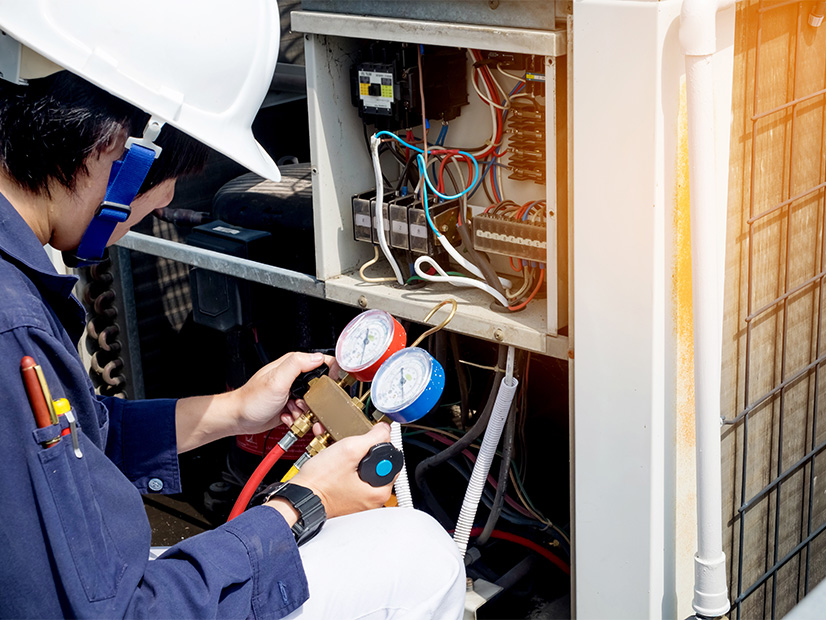EPA will have to rework a recent rule implementing a cap-and-trade program on hydrofluorocarbons (HFCs) used in air conditioners and refrigerators after a court ruling on Tuesday.
A majority of a three-judge panel of the D.C. Circuit Court of Appeals found that the agency exceeded its statutory authority by requiring the industry to adopt a system of refillable containers that could be tracked with QR codes so it could effectively track overall HFC use.
Judge Justin Walker wrote the majority opinion, joined by Judge Karen LeCraft Henderson. Judge Cornelia Pillard wrote a partial dissent on the refillable cylinders issue, agreeing with her colleagues in rejecting other challenges to EPA’s rule.
HFCs are greenhouse gases that, the agency said, “can be hundreds to thousands of times more potent than carbon dioxide.” They have been used for cooling technologies since Congress required the industry to phase out chlorofluorocarbons in 1990, which were depleting the ozone layer.
“That prompted a shift to HFCs,” the majority decision said. “But Congress’ change swapped one environmental hazard for another.”
Congress in 2020 passed the American Innovation and Manufacturing Act, which required EPA to issue a rule phasing down HFCs through a cap-and-trade program. The law provided an outline for how that program will work, leaving the agency to fill in the details.
EPA is required to calculate the baseline levels of HFC production and consumption in the U.S. and then cap maximum production and consumption at a percentage of those baselines, with the aim of capping the gas at 15% in 2036. The agency hands out allowances to HFC users initially, but users can buy and sell them from one another to adjust their production or consumption capacity.
While it rejected two other challenges, the two-judge majority found that EPA exceeded its authority by requiring QR codes and refillable cylinders. The law lays out the rate of decline for the cap and tells EPA to “ensure” that happens, but the majority said the agency read too much into the word “ensure.”
Congress just wanted the agency to ensure that the annual cap was not exceeded, the majority ruled; it did not tell the agency how to get that done in that section of the law, but it did offer detailed instructions in other parts. The QR codes and refillable cylinders were expected to cost the industry between $441 million and $2 billion.
“Congress’ exhaustive instructions to the agency throughout the AIM Act make it less plausible that Congress meant the words ‘shall ensure’ in (e)(2)(B) to give the EPA broad power to pass new rules,” the majority said.
The majority’s decision did not rest on the “major questions” doctrine from West Virginia v. EPA, which was issued by the Supreme Court last year. (See Supreme Court Rejects EPA Generation Shifting.) Instead, the court relied on an older precedent from Whitman v. American Trucking Associations, which held that Congress does not alter the fundamental details of a regulatory scheme in vague terms or ancillary provisions.
“Ordinary readers of English do not expect provisions setting out math equations to empower an agency to prescribe other ‘fundamental details of a regulatory scheme,’” the court said. “Because the EPA’s interpretation of (e)(2)(B) seeks to do just that, it strains against the ordinary use of language.”
Pillard’s partial dissent would have sided with EPA on the QR code and refillable cylinder issue, saying they are valid regulations meant to ensure compliance with Congress’ directive.
“The agency determined that, to accomplish the HFC phasedown, it was necessary to require refillable cylinders with unique, trackable QR codes, so it promulgated a final rule to that effect,” Pillard wrote. “After all, requiring refillable and trackable cylinders is a straightforward way to ‘ensure’ that the regulated substances they contain correspond to allowances the statute requires. Without such tools, it is hard to see how EPA can ensure the phasedown.”
The majority decision will make it harder for EPA to “combat illicit trade,” making it less likely that the U.S. achieves the HFC cuts directed by Congress, she wrote.




